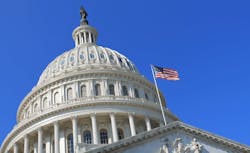At any given time, policy experts at the National Association of Home Builders are working on scores of issues in the regulatory, legislative, and legal arenas. Below is a summary of three key congressional issues and two cases pending in the U.S. Supreme Court that have NAHB’s attention.
Tax Relief Bill
In the House, the NAHB-supported Tax Relief for American Families and Workers Act of 2024 includes a number of pro-business provisions. The nearly $80 billion tax package would:
• Strengthen the Low-Income Housing Tax Credit (LIHTC), which helps to finance the construction of affordable rental housing by temporarily increasing the amount of tax credits issued by 12.5% and providing greater flexibility when using bond financing to build or preserve LIHTC properties.
• Extend the 100% bonus depreciation, increase the maximum amount a tax-payer may expense under Section 179 of the tax code, and increase the threshold for information reporting on Forms 1099-NEC and 1099-MISC.
Job Corps Funding
With strong bipartisan support (44 to 1), the House Committee on Education & the Workforce approved NAHB-supported legislation that would reaffirm congressional support for the Job Corps and help address the nation’s skilled labor shortage.
Of particular importance to NAHB and the housing community, the A Stronger Workforce for America Act explicitly recommends the full $1.7 billion per year in funding for the Job Corps, the nation’s most successful career preparation program for disadvantaged youth. This legislation is especially important given that a recent House Labor-U.S. Department of Health & Human Services budget proposal completely eliminated Job Corps funding. The Home Builders Institute, NAHB’s workforce development partner, is Job Corps’ largest skilled trades training provider.
As a result of the continuing resolution passed by Congress in January, Job Corps funding will continue at its current level until March 8.
Promoting Resilient Buildings Act
In a positive development on the codes front, the House has passed the Promoting Resilient Buildings Act of 2023. The bill would allow the Federal Emergency Management Agency to consider whether a jurisdiction has adopted one of the two latest editions of building codes, rather than just the latest edition, when awarding funds from its pre-disaster mitigation program. It would also allow state and local governments flexibility in amending the codes prior to adoption. The measure is awaiting action in the Senate.
The ‘Chevron Deference’
In 1984, the Supreme Court issued an opinion that created “Chevron Deference” (not to be confused with the oil and gas company), which requires courts to defer to a federal agency’s interpretation of an unclear statute if the interpretation is “reasonable.” In other words, it gives federal agencies the latitude to interpret the scope of regulations.
In January, the Supreme Court heard arguments in two cases challenging the Chevron Deference that are of interest to home builders. Plaintiffs in Loper Bright Enterprises v. Raimondo and Relentless Inc. v. Department of Commerce seek to overturn the statute on the basis that it gives the government an unfair advantage when a regulation is challenged in court.
NAHB filed a friend-of-the-court brief in support of the plaintiffs, arguing that the Chevron Deference is clearly biased toward federal agencies by granting them broad leeway to interpret and implement regulations.
If Chevron is overturned, federal agencies such as the Department of Housing and Urban Development, Occupational Safety and Health Administration, and Environmental Protection Agency—all of which impact home building—will have less discretion to impose new regulations that Congress didn’t clearly authorize.
Impact Fees
In a separate Supreme Court case, Sheetz v. County of El Dorado, Calif., the plaintiff, George Sheetz, argued that a $23,000 traffic impact fee imposed on him by El Dorado County for putting a manufactured home on a small parcel of land was unconstitutional under the Constitution’s Takings Clause.
In a California state court, Sheetz argued that the fee was not closely connected to or proportional to the actual impact his new residence would have on roads. Sheetz lost his decision in California state court and appealed to the U.S. Supreme Court.
NAHB filed a friend-of-the-court brief supporting Sheetz on the merits of the case, arguing that it’s unfair to permit legislative action to shield a government from the Takings Clause. From the property owner’s standpoint, a taking is a taking, no matter how it comes about.
Decisions in these Supreme Court cases are expected between April and June.
Household Income Data: New-Home Buyers vs. First-Time Homebuyers
Roughly 10.2 million households bought and moved into a home during the two years preceding the most recent (2021) American Housing Survey (AHS), sponsored by the Department of Housing and Urban Development and conducted by the U.S. Census Bureau. The data provides up-to-date information about the size, composition, and quality of the nation’s housing and measures changes in housing stock as it ages.
According to NAHB analysis of the 2021 AHS data, the median age of all homebuyers was 41, with a median income of $97,700. The median age of first-time buyers was 33, with a median income of $90,000. And the median age of new-home buyers was 45, with a median income of $112,100.
In addition, roughly 7% of homebuyers purchased a new home and 40% were purchasing their first home. The median market value of the homes purchased was $318,185. The median market value of new homes was $429,205, while the median value of homes purchased by a first-time buyer was $271,445. About 85.7% of the homes purchased were single-family detached, 8.3% were single-family attached, and 6% were multifamily condos. Approximately 18% of the homes were purchased with no down payment and just 16% were bought with a down payment of 20% or more.
About the Author

National Association of Home Builders
The National Association of Home Builders (NAHB) is a Washington, D.C.-based trade association representing more than 140,000 members involved in home building, remodeling, multifamily construction, property management, subcontracting, design, housing finance, building product manufacturing, and other aspects of residential and light commercial construction. For more, visit nahb.org. Facebook.com/NAHBhome, Twitter.com/NAHBhome
